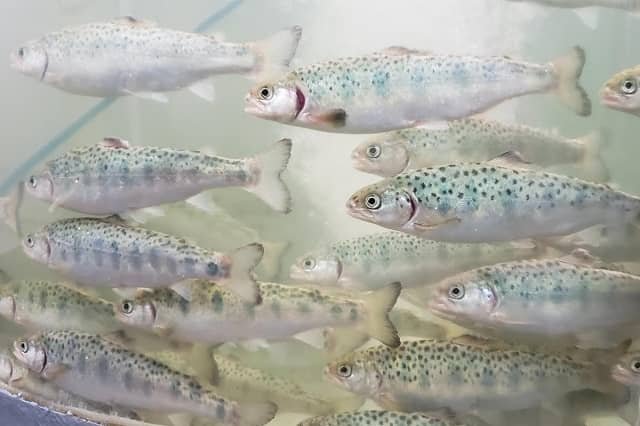
Infectious diseases pose a significant challenge in salmonid aquaculture, as they threaten animal welfare and food security.
Thus, preventing disease outbreaks is a key component in mitigating impacts and requires a detailed understanding of transmission dynamics within a system.
To address these issues and make informed decisions, tools like mathematical models and computer simulations are utilized. These tools allow for predicting potential disease spread and impact.
A recent study by researchers from the Centre for Environment, Fisheries & Aquaculture Science (Cefas) has developed a model called the ‘Aquaculture Disease Network Model’ (AquaNet-Mod) to address these challenges, demonstrating its applicability through a case study of Viral Hemorrhagic Septicemia (VHS).
Disease Spread
According to the scientific community, disease spread can occur through four different mechanisms: fish movement, rivers, short-range mechanical, and long-range mechanical.
Furthermore, disease spread can be interrupted by applying disease mitigation measures and controls, such as contact tracing, culling, fallowing, and surveillance.
AquaNet-Mod Model: A Powerful Tool
Aquaculture Disease Network Model (AquaNet-Mod) is a data-driven and stochastic state-transition model. It describes disease spread in aquaculture through four mechanisms: live fish movement, river-based transmission, short-range mechanical transmission, and long-range mechanical transmission; it incorporates three pathological states (S susceptible, IC clinically infected, and ISC subclinical).
AquaNet-Mod was developed to simulate disease transmission in the salmon industry of England and Wales via different disease transmission mechanisms and the implementation of a range of disease control measures.
Case Study: Viral Hemorrhagic Septicemia (VHS)
The case study focused on Viral Hemorrhagic Septicemia (VHS) and its spread over a 10-year time horizon. The results revealed that without control measures, VHS could spread to an alarming 96% of aquaculture sites.
However, by applying restrictions on live fish movement in the most connected sites, the epidemiological impact was significantly reduced. Furthermore, implementing disease control measures representative of current policies in England and Wales also drastically reduced disease spread.
Highlighting the Importance of Control Measures
The VHS case study demonstrates how AquaNet-Mod can be implemented to simulate viral infectious disease transmission in the salmon industry. Simulation results can be used to infer trends, assess the relative impacts of controls and disease parameters.
The study not only highlighted the effectiveness of restrictions on live fish movement but also emphasized the importance of specific control measures such as contact tracing and disease detection rate. These findings underscore the need for a comprehensive, multi-layered approach to prevent disease spread in aquaculture systems.
Future Perspectives and Applications
The AquaNet-Mod model is valuable not only in assessing disease spread and control effectiveness but also has the potential to influence policy formulation.
Additionally, this model could be expanded in the future to include economic parameters, allowing for a better understanding of the financial impact of diseases on aquaculture.
Furthermore, the AquaNet-Mod framework can be adapted to simulate disease transmission in different aquaculture industries, incorporating various control measures or transmission mechanisms.
Conclusion
The development and application of the AquaNet-Mod model represent a significant advancement in combating infectious diseases in aquaculture. Through its comprehensive, data-driven approach, the model provides crucial information for making informed decisions and developing effective control strategies.
By better understanding how diseases spread and how control measures can influence that process, we can work towards healthier aquaculture systems, improved biodiversity conservation, and greater food security.
“AquaNet-Mod can be adapted to model the potential impact of other WHO-listed diseases and provides valuable evidence for policy decision-making,” the researchers concluded.
The study was funded by the Department for Environment, Food & Rural Affairs.
Contact
Hannah J. Tidbury
Centre for Environment, Fisheries & Aquaculture Science (Cefas)
Weymouth Laboratory, DT4 8UB, UK
Email: hannah.tidbury@cefas.gov.uk
Reference (open access)
James Guilder, David Ryder, Nick G.H. Taylor, Sarah R. Alewijnse, Rebecca S. Millard, Mark A. Thrush, Edmund J. Peeler, Hannah J. Tidbury. The aquaculture disease network model (AquaNet-Mod): A simulation model to evaluate disease spread and controls for the salmonid industry in England and Wales, Epidemics, Volume 44, 2023, 100711, ISSN 1755-4365, https://doi.org/10.1016/j.epidem.2023.100711.
Editor at the digital magazine AquaHoy. He holds a degree in Aquaculture Biology from the National University of Santa (UNS) and a Master’s degree in Science and Innovation Management from the Polytechnic University of Valencia, with postgraduate diplomas in Business Innovation and Innovation Management. He possesses extensive experience in the aquaculture and fisheries sector, having led the Fisheries Innovation Unit of the National Program for Innovation in Fisheries and Aquaculture (PNIPA). He has served as a senior consultant in technology watch, an innovation project formulator and advisor, and a lecturer at UNS. He is a member of the Peruvian College of Biologists and was recognized by the World Aquaculture Society (WAS) in 2016 for his contribution to aquaculture.
